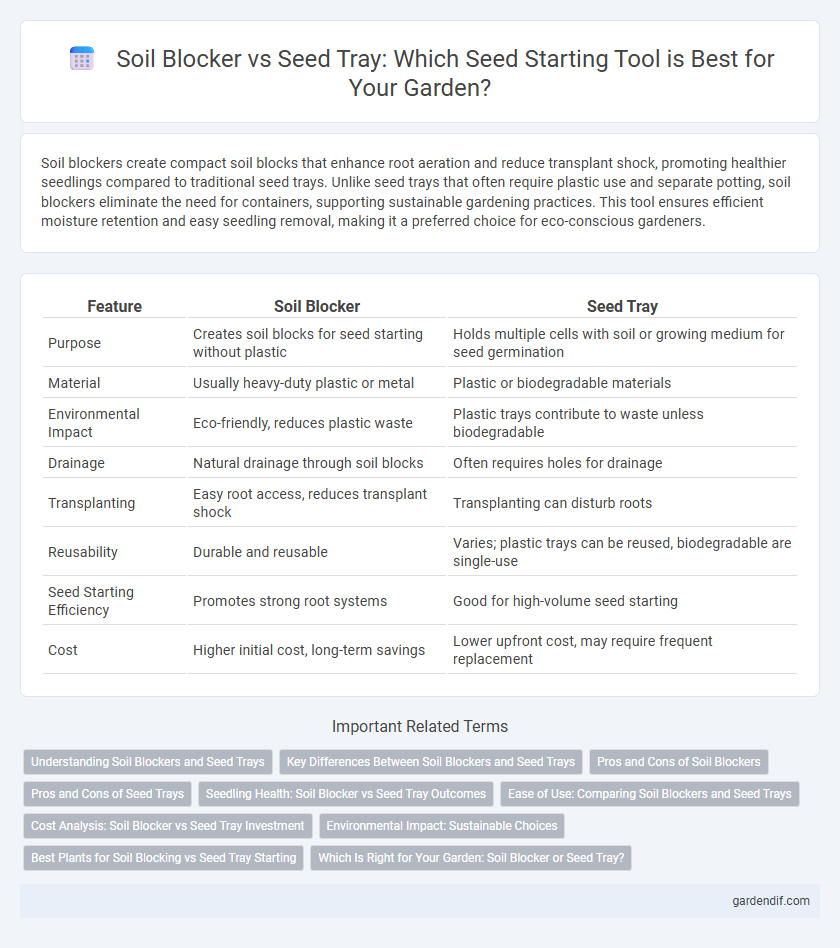
Soil blocker vs Seed tray Illustration
Soil blockers create compact soil blocks that enhance root aeration and reduce transplant shock, promoting healthier seedlings compared to traditional seed trays. Unlike seed trays that often require plastic use and separate potting, soil blockers eliminate the need for containers, supporting sustainable gardening practices. This tool ensures efficient moisture retention and easy seedling removal, making it a preferred choice for eco-conscious gardeners.
Table of Comparison
| Feature | Soil Blocker | Seed Tray |
|---|---|---|
| Purpose | Creates soil blocks for seed starting without plastic | Holds multiple cells with soil or growing medium for seed germination |
| Material | Usually heavy-duty plastic or metal | Plastic or biodegradable materials |
| Environmental Impact | Eco-friendly, reduces plastic waste | Plastic trays contribute to waste unless biodegradable |
| Drainage | Natural drainage through soil blocks | Often requires holes for drainage |
| Transplanting | Easy root access, reduces transplant shock | Transplanting can disturb roots |
| Reusability | Durable and reusable | Varies; plastic trays can be reused, biodegradable are single-use |
| Seed Starting Efficiency | Promotes strong root systems | Good for high-volume seed starting |
| Cost | Higher initial cost, long-term savings | Lower upfront cost, may require frequent replacement |
Understanding Soil Blockers and Seed Trays
Soil blockers create compact, air-pruned soil blocks that promote healthier root systems and reduce transplant shock, making them ideal for seed starting. Seed trays hold loose soil and provide individual cells for seedlings but can lead to root circling and require careful watering management. Comparing soil blockers and seed trays helps gardeners select the optimal tool based on seedling needs and transplanting goals.
Key Differences Between Soil Blockers and Seed Trays
Soil blockers create compressed soil cubes that promote stronger root development and reduce transplant shock, whereas seed trays typically hold loose soil or pellets for germination. Soil blockers minimize plastic use and improve aeration and moisture retention, while seed trays offer more flexibility in size and easy handling for large scale planting. The choice between soil blockers and seed trays depends on factors like sustainability goals, plant type, and available space for seed starting.
Pros and Cons of Soil Blockers
Soil blockers create compact, air-pruned soil blocks that promote healthy root development without the need for plastic containers, reducing transplant shock and environmental waste. However, soil blockers require consistent moisture management and may have a steeper learning curve compared to seed trays, which offer easier handling and moisture retention. Despite these challenges, soil blockers improve root structure and reduce risk of damping-off diseases, making them a preferred choice for sustainable gardening.
Pros and Cons of Seed Trays
Seed trays offer excellent moisture retention and space efficiency, ideal for starting multiple seedlings in controlled environments. However, they can be prone to poor drainage and root entanglement, which may hinder transplanting success. Compared to soil blockers, seed trays require careful monitoring to prevent overwatering and disease spread.
Seedling Health: Soil Blocker vs Seed Tray Outcomes
Soil blockers promote healthier seedlings by allowing better root aeration and reducing transplant shock compared to traditional seed trays, which often cause root circling and distortion. The natural soil structure in soil blocks encourages robust root development and facilitates easier transplanting, enhancing seedling vigor. Seed trays may retain excess moisture, increasing the risk of damping-off disease, whereas soil blockers maintain optimal moisture balance for seedling health.
Ease of Use: Comparing Soil Blockers and Seed Trays
Soil blockers offer superior ease of use by eliminating the need for plastic trays and minimizing transplant shock through air pruning, which promotes healthier root systems. Seed trays are often simpler for beginners due to their straightforward design and ready availability but require more frequent watering and careful handling during transplanting to prevent root disturbance. Choosing between soil blockers and seed trays depends on balancing convenience and optimal seedling health, with soil blockers favored by experienced gardeners aiming for cleaner, more sustainable planting methods.
Cost Analysis: Soil Blocker vs Seed Tray Investment
Soil blockers typically require a higher initial investment compared to seed trays due to their durable, heavy-duty construction and reusability, which reduces long-term costs. Seed trays offer a lower upfront cost, but frequent replacement and consumable use can increase overall expenses. Evaluating the total cost of ownership reveals soil blockers as more economical for sustainable, large-scale seed starting operations.
Environmental Impact: Sustainable Choices
Soil blockers reduce plastic waste by eliminating the need for disposable seed trays, promoting sustainable gardening practices through natural soil compression. Seed trays, typically made from plastic, contribute significantly to environmental pollution when discarded after a single use. Choosing soil blockers supports eco-friendly gardening by minimizing plastic consumption and encouraging biodegradable alternatives.
Best Plants for Soil Blocking vs Seed Tray Starting
Soil blockers provide optimal conditions for starting herbs, leafy greens, and root vegetables like carrots and beets, promoting healthy root airflow and reducing transplant shock. Seed trays are versatile and suitable for a wide variety of plants, including larger seedlings such as tomatoes, peppers, and flowers that require more space and consistent moisture. Choosing soil blockers supports strong root development in small, delicate seedlings, while seed trays offer flexibility for diverse plant types and larger growth stages.
Which Is Right for Your Garden: Soil Blocker or Seed Tray?
Soil blockers create compact soil cubes that promote healthy root development and reduce transplant shock, making them ideal for organic and sustainable gardening practices. Seed trays offer convenience and versatility with various sizes and compartments, suitable for starting numerous seeds quickly and managing space efficiently. Choosing between a soil blocker and seed tray depends on your gardening goals, the types of plants you grow, and your preference for transplanting methods.
Soil blocker vs Seed tray Infographic

 gardendif.com
gardendif.com